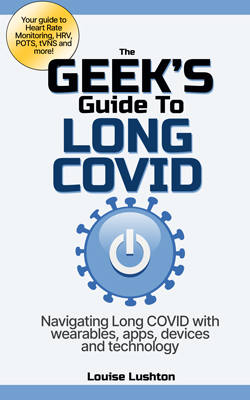An important part of advocating for your own health is documenting it. This involves keeping track of various health measurements and subjective experience on a daily basis and then being able to present that data to health professionals if need be. This becomes especially important if you have a chronic condition like Long Covid. Documenting your health means you have evidence to support yourself if you encounter a dismissive doctor.
What to Document
Here’s a list of things you might want to document. You ultimately decide what’s important to you and what to include.
1. Fatigue, List it on a scale of 1 to 10. This scale might be relative to your illness. 1 might be feeling “normal” and 10 is bedbound, unable to attend to everyday physical needs. Or 10 might be less extreme. Make a note of your relative scale.
2. Energy levels. Keep track of how energetic you feel at different times of the day. This will help to identify what times of the day are good for you and when you’re more likely to be tired.
Advertisement
The Geek’s Guide To Long Covid is available as an ebook!
You’ll find a comprehensive guide to using wearables, apps and technology to cope with Long Covid. It offers detailed instructions on pacing, heart rate monitoring, HRV, POTS, deep breathing, tVNS, air purifiers, CO2 monitors and lots more.
Available from Amazon
3. Mood, List it on a scale of 1 to 10. This is important if your mental health has been affected. It may also give an idea of how you’re feeling overall.
4. Symptoms. Make a list of all the symptoms you experience. List what was present on the day, severity (scale of 1 to 10), when it happened.
A possible list of symptoms includes:
- Chest pain
- Palpitations
- Shortness of breath
- Brain fog (eg difficulty concentrating, loss of words, memory loss)
- Headache
- Muscle pain
- Joint pain, nausea
- Vomiting
- Diarrhoea
- Rash or allergy symptoms
- Fever
- Dizziness
- Cough
- Relative loss of smell or taste
- Bloating
- Reproductive/menstrual issues.
5. Factors. These are elements of your life that may have an impact on your health.
A possible list of factors includes:
- Exercise
- Work – Hours worked, what type (mental, physical)
- General activity e.g. housework
- Mental stress
- Amount of rest during the day – naps, meditation
- Appointments
- Places Visited
- Social contact
- Illness
- Menstruation
6. Sleep. When fatigue is a symptom, keeping track of sleep is very important. Perhaps rate it on a scale of 1 to 10
- A list of things to include:
- How long you slept
- The quality of your sleep
- Early or late bedtime
- Restlessness
- Insomnia
- Wake times
- Snoring
7. Bowel movements. Look up the “Bristol stool chart”. This ranks the nature of your stool (hard pebbles, snakelike or watery) and indicates how your bowels are functioning e.g. constipated, regular, having diarrhoea. Note the type of stool, the time of day (or if nothing happened), how much strain occurred, colour (e.g. black) or presence of blood. Yes, it’s unpleasant but it’s useful, especially if you have gut-related symptoms.
8. Meds and Supplements. Make a list of all the medication, supplements and alternative treatments you are taking. Take note of how much you take (dosage), how many times per day you take it and at what time you take it.
9. Food. What you eat can affect other aspects of your health. If your symptoms are gut or allergy related, this may be especially useful. Keep track of alcohol intake. You may also want to keep track of calories/kilojoules in your food as part of maintaining your weight.
Things to note may include
- Junk food
- Fibre
- Vegetarian
- Gluten
- Red meat
- Pro- or prebiotic.
- Leftovers
10. Health Measurements. These are the objective measurements taken on a daily basis. Wearables like smart watches can help you gather this data.
Health measurements might include:
- Weight
- Resting heart rate
- Highest heart rate
- Blood pressure
- Heart rate variability
- Body battery
- Stress measurements
- Temperature
- SpO2 / oxygen levels
- Daily steps / distance walked
11. Test Results. If you’re able to get hold of blood test results, you may want to include these in your documentation. This will be useful if you will need ongoing tests to monitor your health status. Your doctor might regularly check your iron levels, your thyroid, your liver function, your blood count or a number of other common tests.
Note: If you live in a country where reproductive rights are restricted or monitored, be very careful with tracking menstruation. Check the privacy of your apps if you use them.

How To Document
Diary
The simplest and cheapest way to document these health indicators is to keep a diary and make an entry each night. You don’t have to write down every single thing as long as you make notes. Long-term it may help to make sure you’re scaling things from 1-10 as this can give a quick guide to progress (or lack thereof)
Spreadsheets
The next option is to create a spreadsheet to keep track of things. Put dates on the vertical axis and relevant symptoms and factors on the horizonal one. Leave some columns for comments (or keep on a separate spreadsheet). A spreadsheet will encourage you to convert your subjective experiences into numbers and then this can become data and graphs – which can then be shown to your doctor.
Free spreadsheets to use:
Google Sheets. Cloud-based, similar to Microsoft Excel, auto saves. Be aware that this isn’t great for privacy as Google will require an account and will no doubt use your info in some way.
OpenOffice Calc. Open Office is free open-source software that includes word processing, spreadsheets, presentation software, databases and more. Calc is the spreadsheet and it can be downloaded to your computer and thus the data stays with you. It’s relatively easy to use and can be customized with add-ons. If you have experience with spreadsheets, this will work fine. Because Open Office also has a database creator called Base, you can import your spreadsheet data into it if you want to get more complicated. So Calc is a good option.
Gnumeric. This is another free open source program with a handy user manual.
WPS Office Spreadsheet. This is a commercial piece of software that gives you free access to a simple version of the app.
Apps
A health tracking app can offer a step up from a spreadsheet because they are database-driven and thus can better handle the data you enter. They can offer a more detailed breakdown of data and easily convert it into graphs over selected periods of time, giving a more comprehensive look at your health over time. Be aware that your health data is sensitive information and that you are trusting the app creators with this information. Check privacy terms and conditions before using.
Check the Apps page for more detailed info on these apps.
Bearable (recommended). Keep track of symptoms, medications and daily activities. Convert to graphs easily. Keeps all info private.
Flaredown. Created as a symptom tracking for chronic disease patients. Use pre-set lists of symptoms or add your own. Keeps all info private.
Care Clinic Tracker. Offers symptom tracking, care plans, an appointment calendar, reminders, health records and notes. Creates graphs and correlations. Some data is shared so check the privacy settings.
Patient Strength Long Covid Diary. An app aimed at German and Swiss consumers but anyone can use it. However, anyone can use it. Offers a daily diary where you can record symptoms, food, exhaustion, activities and check health data (heart rate, steps, floors etc). Doesn’t share data. Android and IOS
Responsum for Long Covid. This app mainly offers info.The app is commercial and collects user data so be aware of the privacy implications.
You’ll also find a number of other symptom tracker apps online by typing “symptom tracker” into the search bar of your app store. Most of them are “freemium” apps. Many of these trackers are commercial and may use or sell your data so be aware of your privacy when downloading these.
Databases
Memento Database. Create your own database on desktop or your phone (Apple or Android). This software lets you create a database from scratch using a variety of fields. It also comes with templates that let you get started fast, including a medical records template. The database can analyze, organize and filter your data and create graphs, calendars and other visual representations. You can store the data in the cloud and sync with various devices. You can also export the data as a CSV file. Memento is free but you can pay extra for more cloud storage and functionality. Info on templates here: http://help.mementodatabase.com/?ht_kb=working-with-templates
Base By Open Office. Like the Calc spreadsheet, Base is part of the open source office software called Open Office. Base lets you build a database from scratch and comes with pre-made template setups if you’re new to it. It’s not super user-friendly but there’s a lot of information in the manuals. It lets you create tables, queries, forms and reports.
Trackers, watches, wearables and devices can help you get more objective measurements. Check out the Wearables For Long Covid page for more info.

